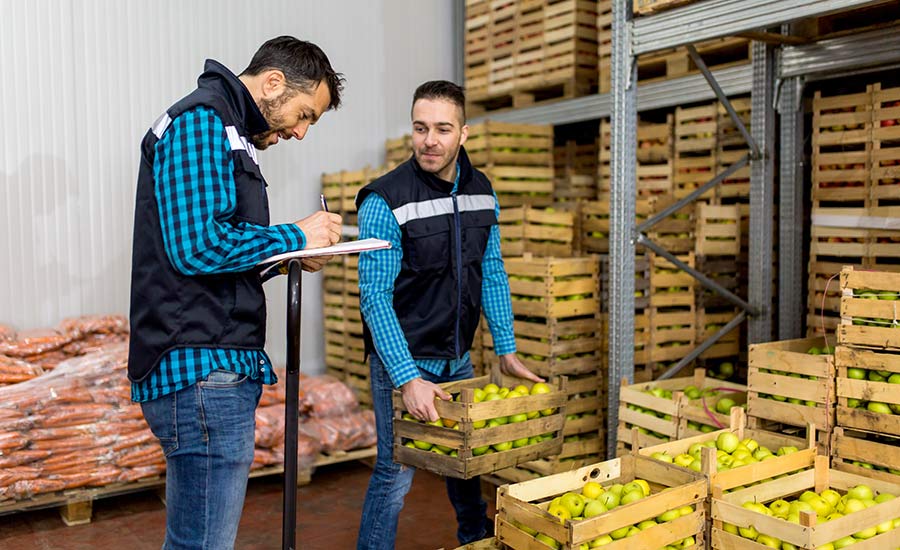
From ensuring your refrigerator is working properly to storing dry goods six inches from the floor, a detailed food storage checklist is key to preventing foodborne illnesses in the kitchen, and maintaining a positive image for your establishment.
In this article, we’ll share what a food storage checklist should include. Plus, we’ll explain how to digitize your checklist so you can fill out, modify and save custom checklists, and share them with your employees wherever you are.
Table of Contents
Simplify your checklists
Try doForms for free!
What Is A Food Storage Checklist?
A food storage checklist is a list of daily tasks that employees must complete to ensure that dry goods, refrigerated products and other food inventory is stored properly.
Once a task is completed, employees write their initials or place a checkmark next to the task.
A food storage checklist helps ensure that food is safety maintained and prevents costly ramifications such as food waste, penalties, or worse, the closure of your establishment.
Food service establishments such as restaurants, bakeries and even groceries can benefit from a daily food storage checklist.
(Speaking of restaurants, check out our comprehensive restaurant operations checklist!)

A food storage checklist ensures that every step is taken to provide safe and delicious meals for your customers
What Should Your Food Storage Checklist Include?
Here’s what your food storage checklist should include:
1. Dry Goods
Dry food includes baking supplies, canned goods and grains that must be stored in dry and dark storage areas to prolong shelf life.
- Ensure that the temperature of your dry goods storage area is set up at 50°F to 59°F (10°C to 15°C) to prevent spoilage and swelling of canned goods
- Check the temperature daily
- Ensure your dry goods storage area has adequate air circulation to prevent the growth of bacteria and mold
- Ensure your dry goods storage area is free from pests such as flies, cockroaches and rats
- Lock your dry goods storage area from unauthorized employees to prevent theft
- Store dry goods away from direct heat and sunlight to maximize storage time
- Store dry goods six inches from the floor to allow room to clean around
- Store dry goods 18 inches away from walls to minimize the chances of condensation, which can be caused by temperature differences between the container and the wall’s surface
- Separate dry goods from chemicals and cleaning products to prevent residue from being absorbed, if accidental damage occurs
2. Refrigerated Products
Refrigerated products are goods that depend on cooler storage temperatures to maximize shelf life and prevent bacterial growth.
- Make sure your refrigerator is working properly
- Keep your refrigerator temperature at 37°F (4°C)
- Ensure your refrigerator closes firmly to maintain proper temperature
- Utilize a refrigerator thermometer to monitor the temperature
- Seal refrigerated food in airtight containers and storage bags to prevent cross-contamination and spills
- Regularly clean your refrigerator from spills
- Label the expiration date on storage bags and containers
- Check your refrigerator once a week for expired food
- Clear expired or nearly-expired food from your refrigerator to prevent food poisoning
- Check refrigerated food for potential mold. If food is moldy, wrap it up and throw it in the trash to prevent mold spores from spreading.
- Make sure your refrigerator has enough open, slotted shelving to allow air circulation around refrigerator walls and shelves
- Avoid overloading your refrigerator. Overloading can affect the refrigerator’s efficiency, as cold air requires enough space to circulate.
3. Frozen Food
Frozen products are products that are kept frozen until cooked.
- Maintain your freezer at 0°F (-17.78°C) or below
- Utilize a thermometer to monitor the freezer’s temperature
- Store frozen food in freezer bags and freezer-safe containers, which are less likely to tear or puncture
- Store frozen food in portion-sized chunks for easy defrosting
- Wrap frozen baked goods and meat tightly with foil before placing them in freezer bags. This protects the food from freezer burn or the process of losing moisture from the frozen food.
- Cool down hot food before freezing it, to prevent bacterial growth
- Write the food date on freezer bags or containers to keep track of shelf life
4. Dairy Products
Dairy products are products that are made from or contain milk.
- Store dairy products as soon as you purchase them to promote longer shelf life
- Store dairy products at 36°F to 39°F
- Store dairy products at the back or lower shelves of your refrigerator (the coldest part of the refrigerator) so they last longer
- Store dairy products in airtight containers to prevent them from absorbing strong odors from other refrigerated food
- Store milk in its original container to protect its flavor and nutritional value
5. Produce
Produce such as fresh fruits and vegetables can either be stored in the refrigerator or in a dry storage area.
- Store cold-season crops such as cabbage and brussels sprouts at 32°F. To keep them crisp, wrap them tightly in plastic.
- Store warm-season crops like corn, cucumbers, and tomatoes at 40°F. You can store them for up to a week.
- Store soft fruits such as berries at 36° to 40°F. You can store them for up to five days.
- Keep produce such as potatoes, tomatoes, garlic and onions out of the fridge and store them in a dry, dark and cool place with air circulation
6. Fresh Meats, Poultry, and Seafood
Fresh meats, poultry and seafood must be refrigerated at a temperature of 34°F or lower to prevent bacterial growth that can cause foodborne illnesses.
Meat
- Store fresh meat in the refrigerator at 34° to 40°F
- Store fresh meat on the lowest shelf to prevent cross-contamination
- Store fresh meat in glass or stainless-steel containers, as these containers don’t absorb strong odor
- Label meat containers with the storage date
- Store fresh meat within two days of use. If you won’t be using the fresh meat within two days, freeze it to extend shelf life
- Properly seal containers to prevent freezer burn and keep the meat fresh
- Wrap the meat in plastic to prevent it from leaking
- Place absorbent paper under the meat for easy cleanup
- Store beef, pork and lamb for up to five days in the fridge
Poultry
- Use cling wrap to protect your fresh poultry
- Store fresh poultry at 38° to 40°F
- Store raw poultry in a bowl or on a platter at the bottom of your refrigerator to prevent cross-contamination
- Store fresh poultry for up to two days in the fridge
Seafood
- Store fresh seafood at 30°F to 34°F
- Use cling wrap to protect your fresh seafood
- Store fresh seafood in a shallow sealed glass or stainless-steel container to prevent odor
- Store fresh seafood at the bottom of your refrigerator, under ready-to-eat and cooked foods
- Store fresh seafood for up to two days in the fridge
Ready to build your food storage checklist
Try doForms for free!
Food Storage Guidelines For Restaurants
Proper food storage is one of the most important aspects of running a restaurant. Food storage prevents your establishment from contributing to landfills and ensures that the food you serve is safe to eat.
1. Check Signs Of Food Spoilage Upon Delivery
Once the goods are delivered to your restaurant, check each product for any signs of spoilage. For dry goods, check the best before and expiration dates.
Signs of spoilage include unpleasant odor, mold or a change in color and texture.
If you smell unpleasant odors, call your delivery partner and return the goods.
2. Store Chemicals In A Separate Area
Keep toxic chemicals and cleaning products away from food to prevent potential contamination.
3. Retrieve Goods Using The FIFO Method
The first in, first out (FIFO) method is the process of retrieving goods that were stored first. FIFO ensures your food establishment cycles through your stock properly, to keep goods fresh.
4. Utilize Ideal Temperatures
Make sure your goods are stored at the ideal temperature to prolong shelf life.
5. Label Your Food Containers
Utilize label stickers to mark your food containers. Write the food name, date of purchase and use by date on the label.

Maintain a positive brand reputation when you follow a food storage checklist
Streamline Your Food Storage Checklist With doForms
doForms offers mobile forms solutions that transform your paper food storage checklists into a digitized and streamlined system, saving you as much as $8,000 per year on printing alone!
Our mobile app allows you to create, edit, submit and save checklists in a secure, centralized location, all from the touch of your smartphone or tablet.
With more than 30 drag-and-drop features and a user-friendly dashboard, our mobile forms are the most effective and secure method for creating, storing and sending checklists and reports for your food establishment.
Don’t have WiFi nearby? doForms also supports offline form submission, so you can fill out forms even without a stable internet connection.
In addition to food storage checklists, which you can easily customize when a new task arises, going the paperless route allows you to:
- Communicate food storage repairs and inventory budget issues in real-time
- Manage food inventory, operational costs, restaurant sales and employee performance reports
- Report near misses in the workplace
- Edit templates and export employee payroll forms
- Access employee time sheets and schedules at any time, from any device
- Minimize the risk of sharing sensitive information such as employee appraisals and payroll, thanks to features such as encrypted security through HIPAA compliancy and multi-factor authentication
Say goodbye to paper checklists with doForms.
Start your free trial!
Safe Food Storage FAQs
1. What Is Safe Food Storage?
Safe food storage is the process of keeping food safe from contamination and spoilage.
From using correct food storage containers to storing food at the correct temperature, food storage is paramount to both food safety and quality.
2. How Far Off The Floor Should Food Be Stored?
Food must be stored at least six inches off the floor to prevent contamination from dirt, dust, and other debris that can accumulate on the floor.
In addition, this keeps food out of the reach of pests and rodents.
3. Which Food Items Should Be Stored On The Top Shelf?
Ready-to-eat food including cooked meats and dessert should go on the top shelf to prevent cross-contamination from raw food.
4. What Is The Proper Temperature For Dry Food?
Keep dry foods at 50°F for maximum shelf life.




